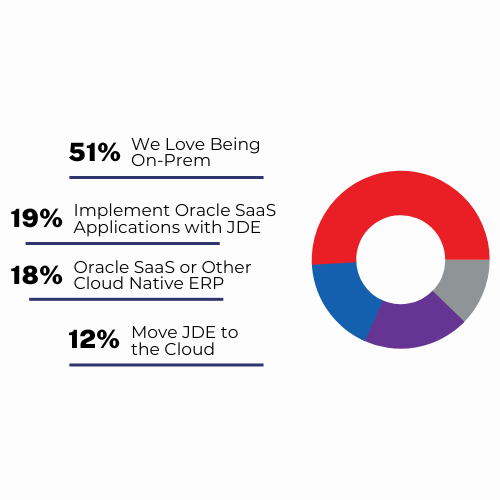
As the technology landscape evolves, cloud strategies have become a focal point for organizations seeking to maximize the potential of their Enterprise Resource Planning (ERP) systems. At BLUEPRINT 4D, we conducted an in-depth survey among 57 participants, all esteemed companies with Oracle ERP systems (JD Edwards “JDE” or PeopleSoft).
In this report, we delve into the responses and reveal how these participants are approaching their ERP cloud strategies, offering valuable insights to guide your organization towards an informed and successful cloud transformation journey.
Summary
-
A surprisingly strong preference for on-premises ERP systems, driven by a desire for familiarity and stability. This reliance on existing systems may be influenced by the comfort of well-established processes and the need to retain control over sensitive data.
-
It’s also noteworthy that traditional on premises infrastructure has historically been a capital expenditure (“capex”) versus an operating expense (“opex”) – depending on whether the you lease or buy. Cloud infrastructure costs are considered an opex, so budgeting may need to change, too.
-
Embracing a hybrid approach, integrating Oracle SaaS applications with on-prem ERP systems like JD Edwards (JDE), presents an attractive option for organizations that want the best of both worlds.
-
Comparable with a hybrid approach, we see a healthy amount of respondents wanting to shift towards a full cloud adoption and away from the on-prem ERP environment, exploring Oracle SaaS and other Cloud Native ERP solutions.
Insights From Blueprint 4D
We Love Being On-Prem
To our surprise, 51% of participants in our ERP cloud strategy survey expressed unwavering affection for on-premises ERP. This preference reflects a reliance on familiarity and stability, as these systems have long served as operational backbones. The reluctancy to move to the cloud may stem from the desire to maintain control over sensitive data and preserve a sense of ownership. However, resource constraints, lack of expertise, and concerns about data security pose challenges to cloud migration. Legacy systems and customizations also contribute to the on-premises allure. Striking the right balance between stability and innovation is vital for organizations aiming to stay competitive. We expect to see this percentage decrease overtime as the cloud migration becomes less daunting and more positive use cases emerge.
Implement Oracle SaaS Applications with JDE
Embracing a hybrid approach, 19% of participants expressed interest in integrating Oracle Software-as-a-Service (SaaS) applications with JDE. This strategy capitalizes on the potential synergy between on-prem ERP and cloud applications, enabling enhanced operational capabilities and seamless collaboration. The hybrid model allows organizations to leverage cloud-based innovations while maintaining their on-premises ERP investment, facilitating a smoother transition to the cloud. A common pattern we see is to “lift and shift” JD Edwards EnterpriseOne to Oracle Cloud first, and add on additional Oracle SaaS capabilities like EPM, Accounting Hub, HCM and more. Learning from success stories and best practices, organizations can implement this hybrid synergy to unlock the full potential of their ERP systems and drive efficiency and innovation. With the momentum of moving from on-prem to the cloud, this hybrid model will continue to be used as a “best of both worlds”.
Oracle SaaS or Other Cloud Native ERP
A noteworthy 18% of participants have expressed their intent to explore Oracle SaaS and other Cloud Native ERP solutions, signifying a strategic shift away from JD Edwards towards full cloud adoption. The allure of modernization and scalability is evident, propelling organizations to seek alternatives that align with their evolving business needs. Some respondents have expressed a desire to “rethink” their ERP – by simplifying their environments with little to no customizations. Adopting Oracle SaaS and other native cloud applications “as is” without customizing is a key driver. However, navigating this transformation is not without its complexities. Integrating Oracle SaaS and Cloud Native ERP demands meticulous planning to ensure seamless data migration and system compatibility.
Move JDE to the Cloud
At a trade show full of JDE users, we were also surprised that only 12% of users wanted to or have already moved their JDE to the cloud. Embracing cloud technology can unlock a host of benefits, including enhanced scalability, security, accessibility, and streamlined operations. Migrating JDE to the cloud allows organizations to modernize their ERP system, adapt to changing business needs, and optimize resource utilization. Based on the overwhelming response to being on-prem, companies might not be ready for the “lift and shift” to the cloud today.

